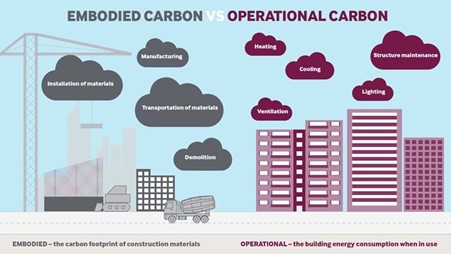
11 Apr B Corp – We Go Beyond – Addressing the Carbon Challenge
The Greenhouse Gas (GHG) emissions of our sector have unfortunately risen by 20% over the last 30 years, which is at odds with a UK-wide decrease of 40%.
Why is this the case when there are innovative solutions, and a collective will of many that work in the sector? Is it due to the sheer scale and legacy of the construction sector taking time to change? The inability for specialist solutions to become the norm? Or is it the perception that sustainable design is more costly?
Perhaps it is a combination of all the above, alongside strategic policy not being stringent enough and has so far been a ‘carrot’ as opposed to the ‘stick’.
As the urgency and pressure of the climate crisis intensifies and the focus of the UK’s planning policies move towards enhanced low-carbon compliance and future landlord obligations on EPC standards across all sectors, the ‘stick’ for better practices is coming.
All about carbon…
Most carbon emissions produced from buildings and construction results from operational activities like energy use, transportation, and material manufacturing. However, there is a chunk of this carbon that is ‘hidden’. This is called embodied carbon.
Embodied carbon contributes 11% to GHG emissions, by 2060 this is expected to exceed 230 gigatons if nothing changes. 1 gigaton alone equals 5.5 million blue whales. This is a lot of carbon!
If we can find this carbon in all our buildings and materials alongside making our operational activities greener, we have the potential to reduce our sector’s impact on the climate.
What is embodied and operational carbon?
Embodied Carbon
Embodied carbon is the amount of carbon emitted during the construction of a building. It is the carbon related to all activities throughout the supply chain, including the extraction of materials, manufacturing process, and maintenance all the way to a project’s end-of-life processing.
Operational Carbon
Operational carbon is the carbon emitted once a building is in use. This is much easier to measure than embodied carbon. It entails monitoring and lowering emissions where possible with more efficient energy and power.
WWA and Carbon Leadership
We are responsible for the carbon produced by our internal operations and externally in this sector. The WWA team are currently delivering sustainability advice within our core services by examining the Life Cycle Carbon Assessment of projects.
To achieve Net Zero, it is essential to reduce the amount of embodied carbon to an absolute minimum.
A way of reducing carbon is using a Life Cycle Assessment (LCA) of projects
The LCA assesses the design and quantity information by extracting information from a large database of materials, services and building scenarios. This enables the ability to understand the environmental impact of the building and its structure alongside a materials lifecycle.
With this there is the opportunity to deliver cost versus carbon options and holistic advice to clients to make the most impactful decision.
Emma Sutton, Senior Project Manager and Technical Service Lead on Carbon Life Cycle Assessments explains: “Using a Life Cycle Assessment has offered huge benefits. For example, one project saved 400 return flights to New York worth of carbon by considering the alternative through refurbishing. This amount of carbon is crucial at the stage we are at in the world we live in.”
The Environmental Audit Committee (EAC) have recommended that governments make it a mandatory requirement for buildings to measure whole-life carbon assessments.
Emma said: “Where other countries such as The Netherlands and France have already established requirements for all building’s whole-life carbon assessments to be measured, we anticipate that it is only a matter of time before the UK implements these requirements. WWA is actively learning and embedding this approach now, as we look to the future.”
“The breadth of how information is shown, from graphs, tables and diagrams is great to present visually to any stakeholders. The difference of impact between a new build and a refurbished project is made really clear and the benefits in the long-term become obvious.”
By focusing on ‘time, cost, quality and carbon’ it is possible to balance design decisions with cost and carbon impact at all phases of a project. This helps ensure full transparency between the design teams and the client, as Scott James, Partner with WWA sets out:
“The ability to implement clear and effective processes to drive carbon reduction whilst retaining client ambitions is the step-change needed in our sector, and one which we have embraced and will only improve on over time through working with others from across the breadth of our sector. The benefits of taking a complex subject-area and demystifying it for construction professionals and clients through accessible data and design options means that our collective goodwill to delivering better can translate into tangible actions. It’s an exciting time for the sector in making this collective impact, and something which will shape the next 5 to 10 years of professional services in the built environment sector.”
Retrofitting
Retrofitting is fitting new systems designed for high energy efficiency and low energy consumption to buildings that were previously built without them, another key part of decarbonizing the Built Environment Sector.
The UK Climate Change Act 2008 has declared that by 2050, carbon emissions must be reduced by 100%. By 2050, there will be over 20 million homes that will need a ‘deep retrofit’ or refurbishing to prevent energy leakage and poor ventilation to meet this target.
Paloma Hermoso MAPM MCIOB explains: “The potential for retrofitting is enormous and a much kinder option to our planet and people in the long term.”
Retrofitting shrinks energy poverty. By retrofitting a building, energy can be saved and living conditions improve. Higher energy ratings also increase the value of a property. This will improve an individual’s financial, health and well-being status in the long term. Retrofitting reduces the impact on the environment by reducing material and energy use.
Paloma said: “The structure of a building is the expensive part, so why not use the skeletons of a building to make it better for you and the environment.”
Despite its benefits, retrofitting has a bad reputation. Paloma said: “One of the many barriers to Retrofit is that it has bad press, this is because of Cowboy contractors. There is a need to reinvent and rebrand retrofitting.”
Information needs to be made more accessible about the benefits of retrofitting and the value it holds. There is now a Framework available for retrofit projects that is high quality, safe and suited for the future. This framework is PAS 2035 and is a framework that offers roles to support the retrofitting process.
A behavioural shift needs to occur, where not only do we take responsibility as a sector by encouraging retrofit projects, but our society acknowledge how to live differently in a retrofitted home.
Paloma continues: “The beauty about this sector is that the result is so tangible, and it is a proud feeling to see the building you are part of stand tall.”
Where WWA look at the carbon life cycle of a project and are keen to push retrofitting, the reality is that we as a business must improve the scale of projects that offer carbon life cycle assessments and retrofitting.
Carbon Neutral Action Plan
| What we have done so far | Goals for 2023 |
| In 2018 WWA adopted a fleet of electric BMW i3’s to replace previous internal combustion engine cars. A focus on building fabric, LED lightening and energy efficient equipment within offices. Over the Covid period WWA moved to a full data-driven review, partnering with Aardvark Environmental Management, to assess all Scope 1,2 & 3 emissions across 7 offices and 150+ staff in the UK. Cycle to work salary sacrifice scheme. | Leverage the B-Corp internal working group with cross office representation to make sure that staff ideas are raised, reviewed, and implemented. Provide a full programme of carbon literacy, enabling team members to understand the fundamentals of carbon and how collection action and behavioural change can make a real difference at macro-scale. Partnering with Earthshot Prize Nominee team from Ecologi, to ensure science-based, gold-standard carbon offsets are put in place to address our balance of emissions each year. |
Our most recent annual figures have highlighted that more than 85% of our 254 tonnes of CO2 is from travel, with 60 t/CO2e from in-work travel and 156 t/CO2e from commuting.
This is able to support a real focus on future actions and making an impact, with our continued promotion of a cycle-to-work programme and future opportunities for an EV salary sacrifice scheme, incentivization for use of public transport and other such initiatives. It also reinforces the use of EV’s for pool cars, and how this can further be grown across our offices as our office bases and workforce grows.
As with many businesses, protection of the environment and addressing the carbon impacts of our work whilst attempting to support regenerative measures are a key aspect of what we are focused on, both from a professional integrity standpoint, but also from the personal beliefs and passion of those that make up our business. As amazing as it would be, this cannot all be achieved by waving a magic wand across our services and operations. We are determined to address all areas in a data-driven and people-focused way.
Addressing the carbon challenge is not something that any one business or individual can do on their own, and we always welcome discussions, collaborations and action in partnership with others.
By Yasmine Knox and Scott James




